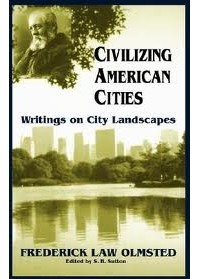Frederick Law Olmsted — об авторе
- Родился: 26 апреля 1822 г. , Hartford, CT, US
- Умер: 28 августа 1903 г. , Belmont, MA, US
Биография — Frederick Law Olmsted
Frederick Law Olmsted was born in Hartford, Connecticut, a member of the eighth generation of his family to live in that city. His mother died when he was four, and from the age of seven he received his schooling mostly from ministers in outlying towns, with whom he lived. His father, a successful dry-goods merchant, was a lover of scenery, and much of Olmsted's vacation time was spent with his family on "tours in search of the picturesque" through northern New England and upstate New York. As he was about to enter Yale College in 1837, Olmsted suffered severe sumac poisoning, which weakened his eyes and kept him from the usual course of studies.
He spent the next twenty years gathering…
experiences and skills from a variety of endeavors that he eventually utilized in creating the profession of landscape architecture. He worked in a New York dry-goods store and took a year-long voyage in the China Trade. He studied surveying and engineering, chemistry, and scientific farming, and ran a farm on Staten Island from 1848 to 1855.
In 1850 he and two friends took a six-month walking tour of Europe and the British Isles, during which he saw numerous parks and private estates, as well as scenic countryside.
In 1852 he published his first book, Walks and Talks of an American Farmer in England. That December he began the first of two journeys through the slaveholding south as a reporter for the New York Times.
Between 1856 and 1860 he published three volumes of travel accounts and social analysis of the South. During this period he used his literary activities to oppose the westward expansion of slavery and to argue for the abolition of slavery by the southern states.
From 1855 to 1857 he was partner in a publishing firm and managing editor of Putnam's Monthly Magazine, a leading journal of literature and political commentary. He spent six months of this time living in London with considerable travel on the Continent, and in the process visited many public parks.
On June 13, 1859, Olmsted married Mary Cleveland (Perkins) Olmsted, the widow of his brother John (who had died in 1857). Daniel Fawcett Tiemann, the mayor of New York, officiated the wedding. He adopted her three children (his nephews and niece), John Charles Olmsted (born 1852), Charlotte Olmsted (who later married a Bryant), and Owen Olmsted.
Frederick and Mary also had two children together who survived infancy: a daughter, Marion (born October 28, 1861), and a son Frederick Law Olmsted Jr., born in 1870. Their first child, John Theodore Olmsted, was born on June 13, 1860, and died in infancy.
Between 1872 and 1895, when he retired, Olmsted's firm carried out 550 projects. These projects included college campuses, the grounds to the US Capitol, and residential communities.
In late 1895 he suffered a mental breakdown and spent his remaining years resting in an Asylum in Waverly Massachusetts. In August 1903 he died.
It was not until 20 years later did people begin to realize the impact and grandness of Olmsted's work, and the vast wonders that he had left the world.
Книги
Смотреть 13Интересные факты
Frederick Law Olmsted (1822–1903) is considered one of America's pioneer landscape architects, he came to the profession only after experimenting and dabbling in many different fields. A newspaperman, social commentator and sometime farmer, Olmsted had many interests early in life. In landscape architecture, he combined his interest in rural life with a sense of democratic idealism to create a new kind of civil engineering that synthesized function and beauty.
Olmsted was anxious to preserve areas of natural beauty for future public enjoyment. He served as the first head of the commission in charge of preserving Yosemite Valley and was a leader in establishing the Niagara Reservation,…


